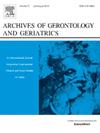Association of social network with the incidence of frailty and depressive symptoms among older adults: a two-year longitudinal study
IF 3.5
3区 医学
Q2 GERIATRICS & GERONTOLOGY
引用次数: 0
Abstract
Background
Social isolation, which includes a limited social networks (SN) as one of its components, is a well-known risk factor for chronic conditions, including frailty and depression. However, associations between diverse SN and these conditions are not well understood. The aim of this study was to examine the associations between SN and frailty and depressive symptoms by gender, age, and economic status.
Methods
A two-year longitudinal study was conducted in Tsuru City, Yamanashi, Japan. Participants included all residents aged ≥65 years without physical disability (n = 3327). Surveys were conducted in January 2022 and January 2024. Frailty was assessed using the Kihon Checklist, depressive symptoms were evaluated by using the Geriatric Depression Scale-15, and SN was assessed using the Lubben Social Network Scale-6. Logistic regression models were conducted to compute odds ratios (OR) and 95 % confidence intervals (CI), stratified by gender, age, and economic status.
Results
During the follow-up period, 15.7 % of participants developed frailty, and 10.6 % developed depressive symptoms. Older adults in the highest SN group were less likely to develop frailty (OR [95 % CI]: 0.62 [0.43, 0.88]) and depressive symptoms (OR [95 % CI]: 0.58 [0.38, 0.89]) compared with those in the lowest SN group. Those associations were more pronounced in females, individuals aged <75 years, and those with poor economic status.
Conclusions
Older adults with larger SN are less likely to develop frailty and depressive symptoms, particularly females, those aged <75 years, and those with poor economic status. This provides useful insights for future interventions.
社会网络与老年人虚弱和抑郁症状发生率的关联:一项为期两年的纵向研究
社会孤立,包括有限的社会网络(SN)作为其组成部分之一,是众所周知的慢性疾病的风险因素,包括虚弱和抑郁。然而,不同SN与这些条件之间的关系尚不清楚。本研究的目的是通过性别、年龄和经济状况来研究SN与虚弱和抑郁症状之间的关系。方法在日本山梨县鹤津市进行为期两年的纵向研究。参与者包括所有年龄≥65岁且无身体残疾的居民(n = 3327)。调查分别于2022年1月和2024年1月进行。使用Kihon检查表评估虚弱,使用老年抑郁量表-15评估抑郁症状,使用Lubben社会网络量表-6评估SN。采用逻辑回归模型计算优势比(OR)和95%置信区间(CI),并按性别、年龄和经济状况分层。结果在随访期间,15.7%的参与者出现虚弱,10.6%的参与者出现抑郁症状。与SN最低组相比,SN最高组的老年人更不容易出现虚弱(OR [95% CI]: 0.62[0.43, 0.88])和抑郁症状(OR [95% CI]: 0.58[0.38, 0.89])。这些关联在女性、75岁以上和经济状况较差的人群中更为明显。结论SN较大的成年人出现虚弱和抑郁症状的可能性较小,尤其是女性、75岁及经济状况较差的人群。这为未来的干预措施提供了有用的见解。
本文章由计算机程序翻译,如有差异,请以英文原文为准。
求助全文
约1分钟内获得全文
求助全文
来源期刊
CiteScore
7.30
自引率
5.00%
发文量
198
审稿时长
16 days
期刊介绍:
Archives of Gerontology and Geriatrics provides a medium for the publication of papers from the fields of experimental gerontology and clinical and social geriatrics. The principal aim of the journal is to facilitate the exchange of information between specialists in these three fields of gerontological research. Experimental papers dealing with the basic mechanisms of aging at molecular, cellular, tissue or organ levels will be published.
Clinical papers will be accepted if they provide sufficiently new information or are of fundamental importance for the knowledge of human aging. Purely descriptive clinical papers will be accepted only if the results permit further interpretation. Papers dealing with anti-aging pharmacological preparations in humans are welcome. Papers on the social aspects of geriatrics will be accepted if they are of general interest regarding the epidemiology of aging and the efficiency and working methods of the social organizations for the health care of the elderly.

 求助内容:
求助内容: 应助结果提醒方式:
应助结果提醒方式:


